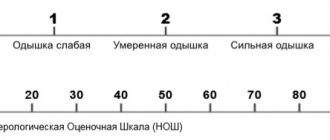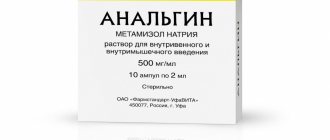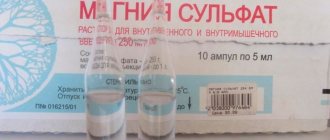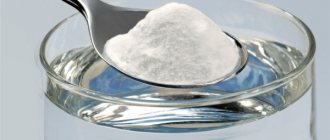pharmachologic effect
Bronchodilator, phosphodiesterase inhibitor (PDE).
It is the ethylenediamine salt of theophylline (which facilitates solubility and increases absorption). It has a bronchodilator effect, apparently due to a direct relaxing effect on the smooth muscles of the respiratory tract and blood vessels of the lungs. It is believed that this effect is caused by selective inhibition of the activity of specific PDEs, which leads to an increase in the intracellular concentration of cAMP. The results of in vitro experimental studies show that the main role appears to be played by type III and IV isoenzymes. Suppression of the activity of these isoenzymes may also cause some side effects of aminophylline (theophylline), including. vomiting, arterial hypotension and tachycardia. Blocks adenosine (purine) receptors, which may be one of the factors affecting the bronchi. Reduces airway hyperresponsiveness associated with the late phase response caused by inhaled allergens through an unknown mechanism that is not due to PDE inhibition or blockade of adenosine. There are reports that aminophylline increases the number and activity of T-suppressor cells in peripheral blood.
Increases mucociliary clearance, stimulates contraction of the diaphragm, improves the function of the respiratory and intercostal muscles, stimulates the respiratory center, increases its sensitivity to carbon dioxide and improves alveolar ventilation, which ultimately leads to a decrease in the severity and frequency of apnea episodes. By normalizing respiratory function, it helps saturate the blood with oxygen and reduce the concentration of carbon dioxide. Strengthens ventilation of the lungs in conditions of hypokalemia.
It has a stimulating effect on the activity of the heart, increases strength and heart rate, increases coronary blood flow and increases the myocardial oxygen demand. Reduces the tone of blood vessels (mainly those of the brain, skin and kidneys). It has a peripheral venodilating effect, reduces pulmonary vascular resistance, and lowers pressure in the pulmonary circulation. Increases renal blood flow and has a moderate diuretic effect. Expands extrahepatic bile ducts. Stabilizes mast cell membranes, inhibits the release of mediators of allergic reactions. Inhibits platelet aggregation (suppresses platelet activating factor and PgE2α), increases the resistance of red blood cells to deformation (improves the rheological properties of blood), reduces thrombus formation and normalizes microcirculation. It has a tocolytic effect, increases the acidity of gastric juice. In high doses it has an epileptogenic effect.
Pharmacokinetics
In the body, aminophylline is metabolized at physiological pH values to release free theophylline. Bronchodilating properties appear at plasma theophylline concentrations of 10-20 mcg/ml. Concentrations above 20 mg/ml are toxic. The stimulating effect on the respiratory center is realized at a lower concentration - 5-10 mcg/ml.
Theophylline binding to plasma proteins is approximately 40%; in newborns, as well as in adults with diseases, binding decreases. Plasma protein binding in adults is about 60%, in newborns - 36%, in patients with liver cirrhosis - 36%. Penetrates the placental barrier (the concentration in the fetal blood serum is slightly higher than in the maternal serum). Excreted in breast milk.
Theophylline is metabolized in the liver with the participation of several cytochrome P450 isoenzymes, the most important of which is CYP1A2. During metabolism, 1,3-dimethyluric acid, 1-methyluric acid and 3-methylxanthine are formed. These metabolites are excreted in the urine. 10% is excreted unchanged in adults. In newborns, a significant part is excreted in the form of caffeine (due to the immaturity of the pathways for its further metabolism), unchanged - 50%.
Significant individual differences in the rate of hepatic metabolism of theophylline are the cause of pronounced variability in clearance values, plasma concentrations, and half-life. Hepatic metabolism is influenced by factors such as age, addiction to tobacco smoking, diet, diseases, and concurrent drug therapy.
T1/2 of theophylline in non-smoking patients with bronchial asthma practically without pathological changes in other organs and systems is 6-12 hours, in smokers - 4-5 hours, in children - 1-5 hours, in newborns and premature babies - 10- 45 hours
T1/2 of theophylline increases in the elderly and in patients with heart failure or liver disease.
Clearance decreases with heart failure, liver dysfunction, chronic alcoholism, pulmonary edema, chronic obstructive pulmonary disease.
Ethylenediamine does not affect the pharmacokinetics of theophylline.
Eufillin's analogs
A fairly common question from patients is: “What can I replace aminophylline with?”
In 2021, about 20 analogues of the drug were registered on the market. The most common ones are presented in the table:
| Name | Price, in rubles | Manufacturer country |
| Theophylline | 160–200 | Russia |
| Berodual | 450–500 | France |
| Salbutamol | 120–160 | France |
| Pentoxifylline | 80–120 | Russia |
Theotard
Manufacturer: KRKA, (Slovenia)
Release form: extended-release capsules 350 mg
Active ingredient: theophylline
Theotard is an analogue of aminophylline in capsules and has a direct bronchodilator effect. This is one of the most common substitutes. The effect is due to long-term circulation (up to 24 hours) of the active substance in the body. Available in the form of extended-release capsules.
Indications for use of Theotard:
- bronchial asthma;
- chronic obstructive pulmonary disease;
- infectious lung diseases.
The average daily dose ranges from 400–900 mg per day. The dosage for children is selected depending on age.
Berodual
Manufacturer: Boehringer Ingelheim, Austria
Release form: drops for inhalation, aerosol for inhalation
Active ingredient: 1 dose contains 50 mcg fenoterol hydrobromide and 21 mcg ipratropium bromide monohydrate
Berodual is a combination medicine containing two active ingredients: ipratropium bromide and fenoterol hydrobromide.
Ipratropium bromide has a muscle relaxant effect due to blocking the main neurotransmitter, acetylcholine. The result is relaxation of the smooth muscles of the bronchi.
Indications for use of Berodual:
- bronchial asthma;
- COPD;
- left ventricular failure.
The analogue of Eufillin Berodual is available in the form of an aerosol for inhalation, as well as in the form of drops for a nebulizer. Application depends on the severity of the pathology.
Nebulizer drops should be combined with sodium chloride solution (5 ml for adults, and 10 ml for children) in the amount of 3-5 drops for children, and 5-10 drops for adults.
Salbutamol
Manufacturer: GlaxoSmithKline, UK, etc.
Release form: aerosol for inhalation
Active ingredient: salbutamol sulfate
Salbutamol is a selective B2-adrenergic receptor blocker. It is an antispasmodic. It begins to act in 3–5 minutes and is eliminated from the body in 30–45 minutes.
Indications for use of Salbutamol:
- relief of attacks of bronchial asthma;
- relief of asthma attacks in COPD.
The analogue of Eufillin, Salbutamol, is used in emergency situations when asthma attacks occur. The dose depends on the severity of the manifestation of the pathological condition.
To relieve an attack of bronchial asthma, you should use Salbutamol, starting with one injection of the inhaler.
Pentoxifylline
Manufacturer: Biokhimik Saransk, Russia
Release form: ampoules of 5 ml and tablets of 100, 200, 300 mg
Active ingredient: pentoxifylline
Eufillin analogue Pentoxifylline belongs to the group of methylxanthine derivatives. The vasodilating, antispasmodic effect is achieved by increasing the lumen of blood vessels, as well as relaxing smooth muscles.
Indications for use of Pentoxifylline:
- cerebrovascular pathology;
- violation of the rheological properties of blood;
- Raynaud's syndrome.
Adults after meals: 0.2 g 3 times a day. To achieve a therapeutic effect, the dose is gradually reduced to 0.1 g.
Ipratropium bromide
A modern analogue of aminophylline, ipratropium bromide, belongs to the group of anticholinergics, the mechanism of which is aimed at relieving bronchospasm, followed by sputum discharge.
Europhorbium compositum C
This is a homeopathic analogue of aminophylline, its effect on the body manifests itself with constant use. Available in the form of drops, as well as in the form of ampoules of 2.2 ml.
Aerophylline
There is an imported analogue of aminophylline - Aerophyllin. This drug contains theophylline at a dosage of 100, 200, 300 mg. Its price varies from 400–450 rubles.
Dispensed with a doctor's prescription.
Analogues of aminophylline for children
Analogues for children include:
- erespal;
- ascoril;
- berodual;
- pulmicort.
Erespal – contains fenspiride, also used as an analogue of aminophylline. Antitussive and expectorant is achieved by expanding the lumen of the bronchi of medium and small caliber and increasing mucociliary clearance. Used for children from 1 year to 12 years. For children it is available in the form of syrup.
A substitute may be medications containing fenspiride (erespal, inspiron). These analogues are available in the form of tablets and syrups for children.
Long-acting aminophylline analogues
Since the drug is eliminated from the body after 6–8 hours, pharmaceutical companies produce long-acting analogues of aminophylline.
This group includes the following medicines:
- Emcast 5;
- Daxas;
- Montelukast.
These drugs belong to the antileukotriene group and have an antispasmodic effect. The effect of these medications lasts 24–72 hours.
Indications
For parenteral use: status asthmaticus (additional therapy), neonatal apnea, ischemic cerebrovascular accident (as part of combination therapy), left ventricular failure with bronchospasm and Cheyne-Stokes type breathing disorder, edematous syndrome of renal origin (as part of complex therapy) ; acute and chronic heart failure (as part of combination therapy).
For oral administration: broncho-obstructive syndrome of various origins (including bronchial asthma, COPD, including emphysema, chronic obstructive bronchitis), hypertension in the pulmonary circulation, cor pulmonale, sleep apnea; acute and chronic heart failure (as part of combination therapy).
Side effect
From the side of the central nervous system:
dizziness, sleep disturbances, anxiety, tremors, convulsions.
From the cardiovascular system:
palpitations, heart rhythm disturbances; with rapid intravenous administration - the appearance of pain in the heart, decreased blood pressure, tachycardia (including in the fetus when taken in the third trimester of pregnancy), arrhythmias, decreased blood pressure, cardialgia, increased frequency of angina attacks.
From the digestive system:
nausea, vomiting, gastroesophageal reflux, heartburn, exacerbation of peptic ulcer, diarrhea; with prolonged ingestion - anorexia.
From the urinary system:
albuminuria, hematuria.
Allergic reactions:
skin rash, itching, fever.
From the side of metabolism:
rarely - hypoglycemia.
Local reactions:
compaction, hyperemia, pain at the injection site; when used rectally, irritation of the rectal mucosa, proctitis.
Other:
chest pain, tachypnea, flushing, albuminuria, hematuria, hypoglycemia, increased diuresis, increased sweating.
Use during pregnancy and breastfeeding
Theophylline penetrates the placental barrier. The use of aminophylline during pregnancy may result in potentially dangerous concentrations of theophylline and caffeine in the blood plasma of the newborn. Newborns whose mothers received aminophylline during pregnancy (especially in the third trimester) require medical supervision to monitor possible symptoms of theophylline intoxication.
Theophylline is excreted in breast milk. When using aminophylline in a nursing mother during lactation, irritability may occur in the child.
Thus, the use of aminophylline during pregnancy and lactation (breastfeeding) is possible in cases where the expected benefit of therapy for the mother outweighs the potential risk for the fetus or child.
Not recommended for use with nebulizers:
- All solutions containing oils
- Suspensions and solutions containing suspended particles, including decoctions and infusions of herbs
- Solutions of aminophylline, papaverine, platyphylline, diphenhydramine and similar products
- Preparations containing alcohol solutions
- Recommendations for inhalations for children:
- Do not force the child to breathe frequently during inhalations
- Do not inhale immediately after meals
- Do not spontaneously prescribe or increase drug doses prescribed by a doctor.
- Allow your child to rest after inhalation
special instructions
Use with caution in severe coronary insufficiency (acute phase of myocardial infarction, angina pectoris), widespread atherosclerosis, hypertrophic obstructive cardiomyopathy, frequent ventricular extrasystoles, increased convulsive readiness, liver and/or renal failure, gastric and duodenal ulcers (history), with recent bleeding from the gastrointestinal tract, uncontrolled hypothyroidism (possibility of cumulation) or thyrotoxicosis, with prolonged hyperthermia, gastroesophageal reflux, prostatic hypertrophy, in elderly patients, in children (especially orally).
Correction of the aminophylline dosage regimen may be required for heart failure, liver dysfunction, chronic alcoholism, fever, and acute respiratory infections.
In elderly patients, a dose reduction may be required.
When replacing the used dosage form of aminophylline with another, clinical observation and monitoring of the concentration of theophylline in the blood plasma is necessary.
Aminophylline is not used simultaneously with other xanthine derivatives. During the treatment period, you should avoid eating foods containing xanthine derivatives (strong coffee, tea).
Use with caution simultaneously with anticoagulants, with other theophylline or purine derivatives.
Concomitant use with beta-blockers should be avoided.
Aminophylline should not be used simultaneously with glucose solution.
Do not use rectally in children.
Groups of inhalation drugs:
- Antiseptics (Furacilin, Dioxidin, Miramistin)
- Antibiotics (Gentamicin, Tobramycin)
- Anesthetics (Lidocaine)
- Hormonal drugs (Cromohexal, Budesonite, Pulmicort, Dexamethasone)
- Immunomodulators (Interferon, Derinat)
- Mucolytics (Fluimucil, Lazolvan, Ambroxol, Ambrohexal, Pulmozyme, Acetylcysteine)
- Bronchodilators (Berodual, Fenoterol, Ventolin, Berotek, Salamol)
- Herbal medicine (Rotokan, Tussamag, Chlorophyllipt)
- Vasoconstrictors (Adrenaline, Naphthyzin)
- Alkaline and saline solutions (0.9% saline)








